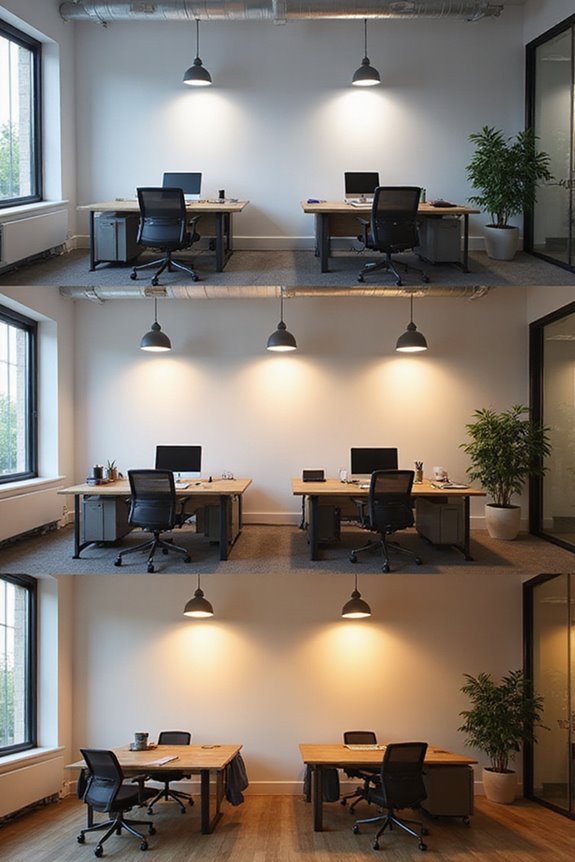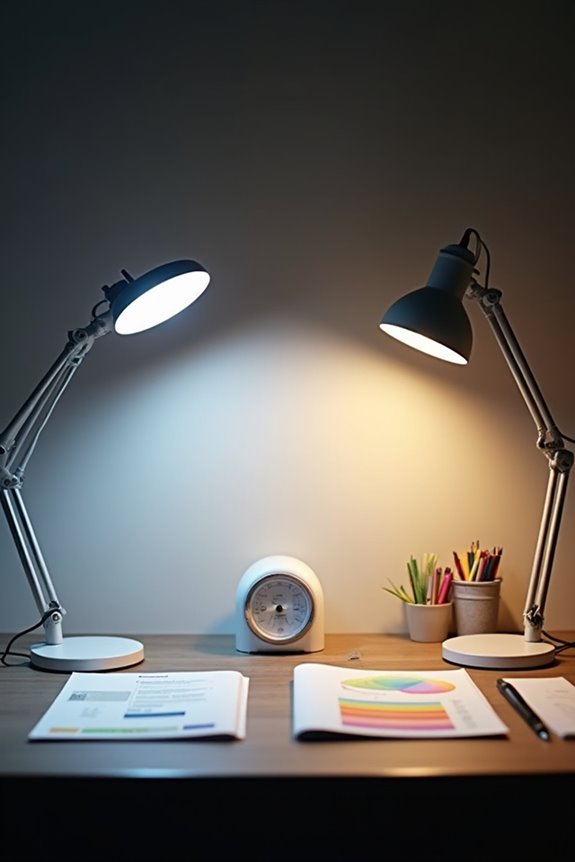To set up automated lighting systems, I recommend starting with the right tools, like a microcontroller, relay module, and light sensors. Make sure to follow safety precautions, such as using protective gear and adhering to electrical codes. Choose between centralized or decentralized systems based on your needs, and budget accordingly. Finally, connect your devices to smart apps for remote control and energy efficiency, allowing you to enhance the overall lighting experience as you learn more about the possibilities.
Key Takeaways
- Begin by evaluating your space and natural light to determine the best lighting needs and solutions.
- Select compatible smart lighting products, considering options like centralized or decentralized systems based on the area size.
- Follow manufacturer instructions to install fixtures correctly, ensuring safety and functionality during setup.
- Configure automation features such as remote control and scheduling for efficient lighting management.
- Regularly test and update device firmware to maintain compatibility and optimal performance of your automated lighting system.
Tools and Materials Needed for Installation
When I set out to install an automated lighting system, it’s vital to gather the right tools and materials to guarantee a smooth and efficient process. First, I make sure I have a microcontroller, like an Arduino Nano, and a relay module to control power to the lights. I also pick up a light sensor to detect ambient light levels. For assembly, a prototyping board is important for testing my circuits.
Next, I gather various connection types, including wires and jumpers, to connect components securely. Additionally, having a soldering iron, wire cutters, and electrical tape makes for solid connections. Finally, I don’t forget the appropriate power supply and LED fixtures to complete my setup, making certain everything functions perfectly together.
Safety Precautions to Follow
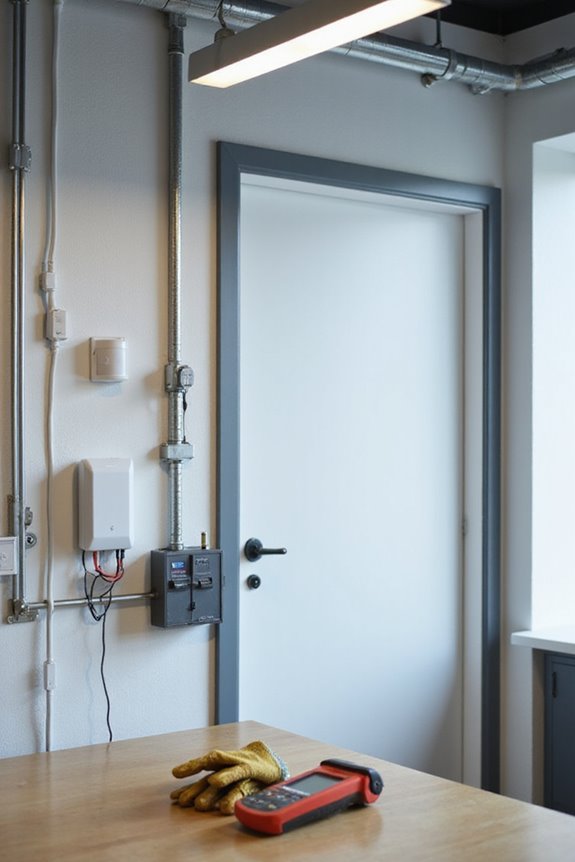
Installing an automated lighting system requires not only the right tools but also a focus on safety throughout the process. First, always follow the manufacturer’s instructions and local electrical codes to guarantee electrical safety. Use appropriate safety gear, such as gloves and safety glasses, during installation.
Before finalizing the setup, test all components to avoid potential electrical issues. Avoid opening smart bulbs to prevent electrical shock and only use bulbs that fit the designated sockets. Be mindful of environmental impact; opt for energy-efficient systems that reduce light pollution. Finally, keep devices away from children and guarantee they’re not placed in hazardous locations or on hot surfaces to maintain safety for everyone involved.
Choosing the Right Type of Automated Lighting
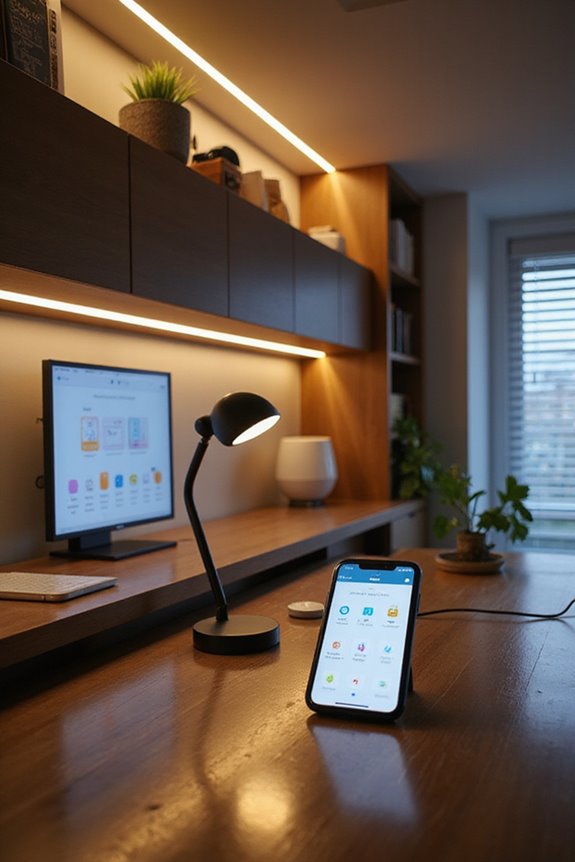
Selecting the right type of automated lighting system can greatly impact both functionality and efficiency in your space. You’ll want to evaluate centralized systems for larger settings, as they manage fixtures from a central hub, allowing for complex lighting scenes and energy savings. If your area is smaller, decentralized systems might be more suitable, offering localized control without a central controller.
Standalone solutions are easy to install and ideal for simple needs, while networked options provide greater flexibility across multiple fixtures. Additionally, cloud-based features enable remote access and real-time analytics, which can be beneficial for distributed locations. Assess your specific requirements and choose the system that best aligns with your lighting goals and installation capabilities.
Planning Your Space for Optimal Lighting
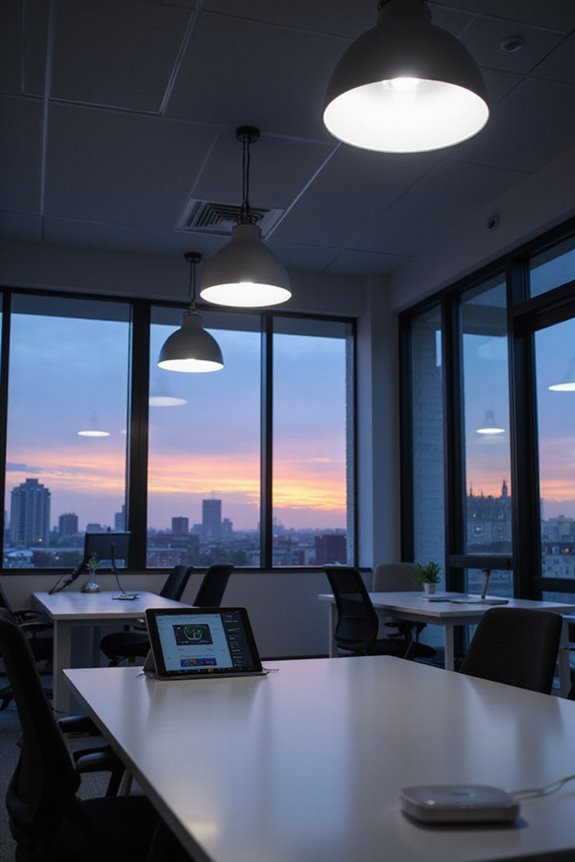
Creating an effective lighting plan involves careful consideration of your space’s unique characteristics and requirements. First, I evaluate the physical layout, dimensions, and any architectural features to inform my lighting layout. Next, I identify the primary functions in each area, determining appropriate lighting levels and control strategies.
I also assess natural light availability to optimize energy efficiency. Zoning is essential; I define lighting zones based on usage and group fixtures with similar control needs. By implementing targeted control methods, like dimming for work areas, I enhance both user convenience and energy savings. Finally, I guarantee that all controls are accessible, accommodating individuals with disabilities while prioritizing safety in high-traffic areas.
Budgeting for Smart Lighting Solutions
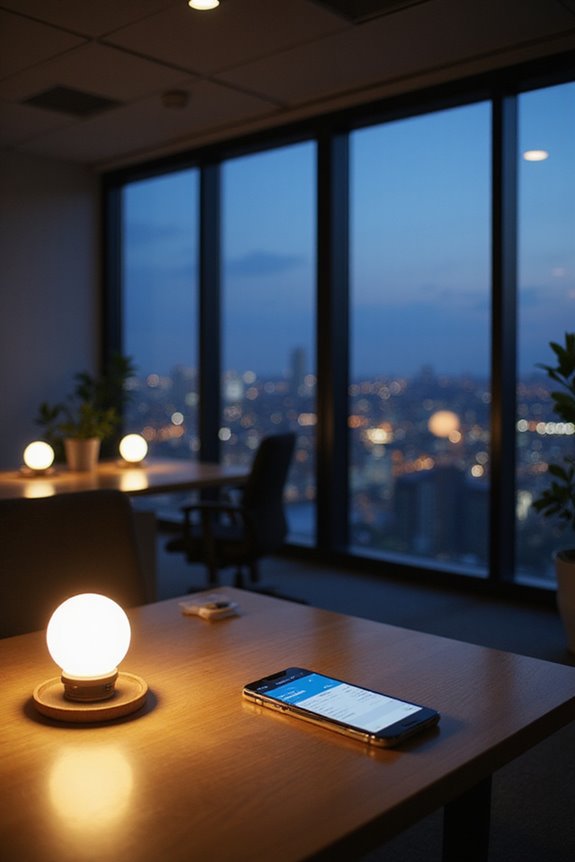
Understanding the financial aspects of implementing smart lighting solutions is key to making informed decisions. When budgeting, I recommend starting with a cost analysis of the types of smart lights available. Options range from budget-friendly bulbs at around $2.24 to high-end models costing up to $90.35.
Consider factors like brand, installation complexity, and whether you need a hub, as these can greatly impact costs. Basic systems may range from $200 to $500 per room, while advanced setups can go up to $2,000.
I also suggest reviewing product reviews to gauge long-term savings from energy efficiency. While the initial investment is higher than traditional lighting, the benefits often outweigh the costs over time.
Step-by-Step Installation Process
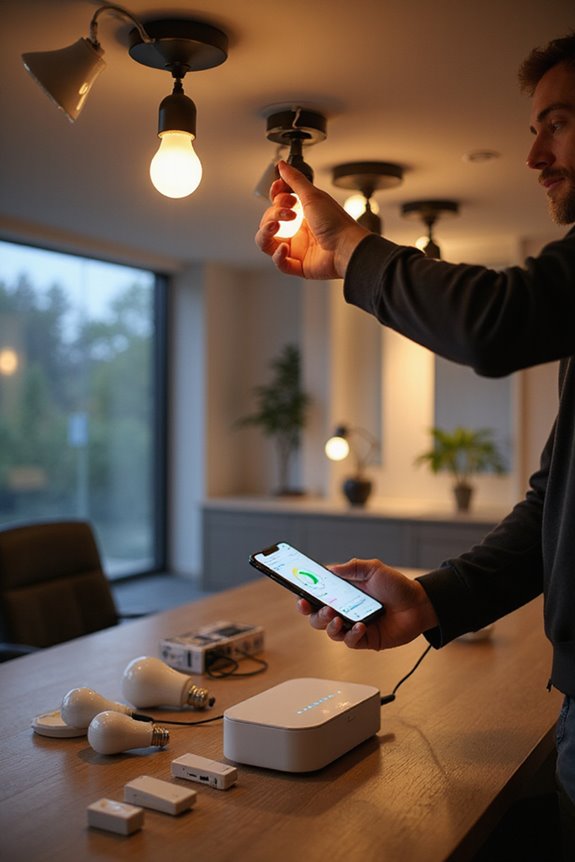
Successfully installing an automated lighting system involves several key steps that can streamline the process and guarantee peak performance.
- Planning and Preparation: Start by evaluating your space, considering both usage and natural light. Choose energy-efficient LED bulbs and identify network requirements for smart home integration.
- Selecting Smart Lighting Products: Pick the right type of LEDs—warm white, cool white, or color-changing—and ascertain compatibility with your smart home system.
- Installing Fixtures: Follow manufacturer instructions for physical installation and secure wiring connections.
- Configuring Automation Features: Set up remote control and scheduling for improved user experience.
- Finalizing the Setup: Organize lights by room and test functionality to ascertain everything operates smoothly.
With these steps, you’re on your way to enjoying automated lighting.
Connecting Your Devices to Smart Apps
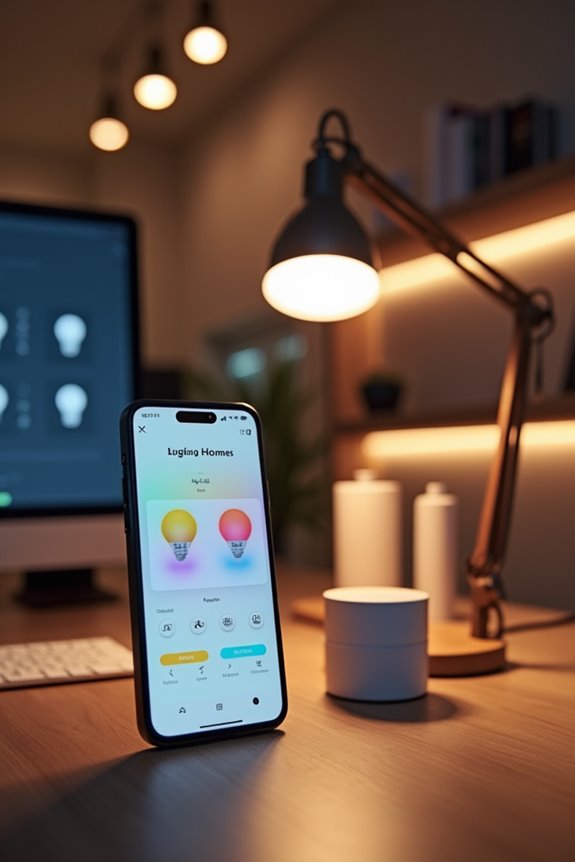
Connecting your devices to smart apps can greatly enhance your automated lighting experience, allowing for seamless control and customization. To get started, verify your devices have the necessary device compatibility. Popular apps like Smart Life, SmartThings, and Apple Home support various products, from smart bulbs to security cameras.
- App Installation: Download the appropriate app from the iOS App Store or Google Play.
- Account Setup: Create an account and grant required permissions.
- Device Discovery: Most apps automatically scan for nearby devices, making app configuration straightforward.
For devices using WiFi or Bluetooth, follow the prompts for connection. Matter-certified devices simplify integration across different platforms, enhancing your smart home setup effortlessly.
Energy Efficiency Benefits of Smart Lighting
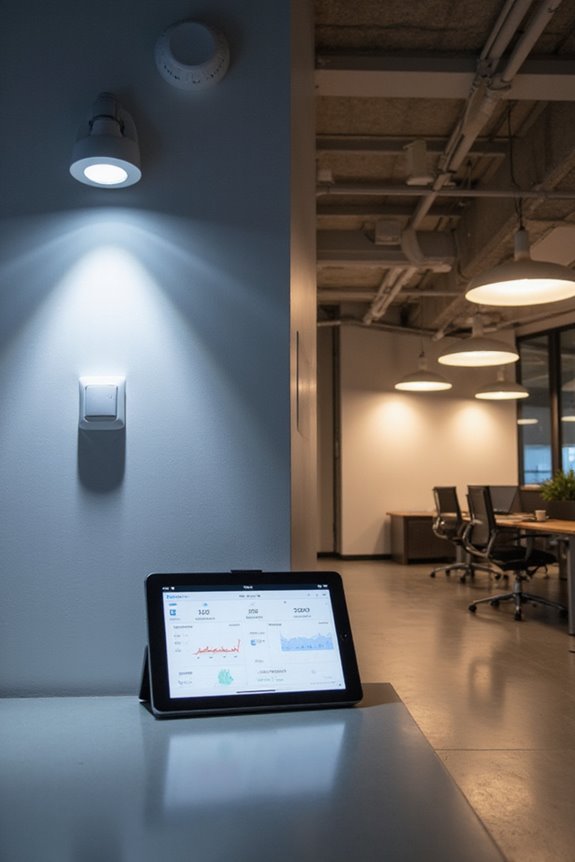
While many people may not realize it, switching to smart lighting can greatly impact both energy consumption and cost savings in your home or business. Smart lighting systems can offer energy savings of 35% to 70% when compared to traditional options. For instance, smart LED bulbs use up to 83% less energy than incandescent bulbs. This not only reduces your electricity bills but also plays a significant role in carbon reduction. By cutting down on energy use, smart lighting helps lower overall carbon emissions, contributing to a healthier environment. In fact, studies show that smart home automation can save around 12.78% of original household emissions, making it a wise choice for both your wallet and the planet.
Security and Safety Features of Automated Systems
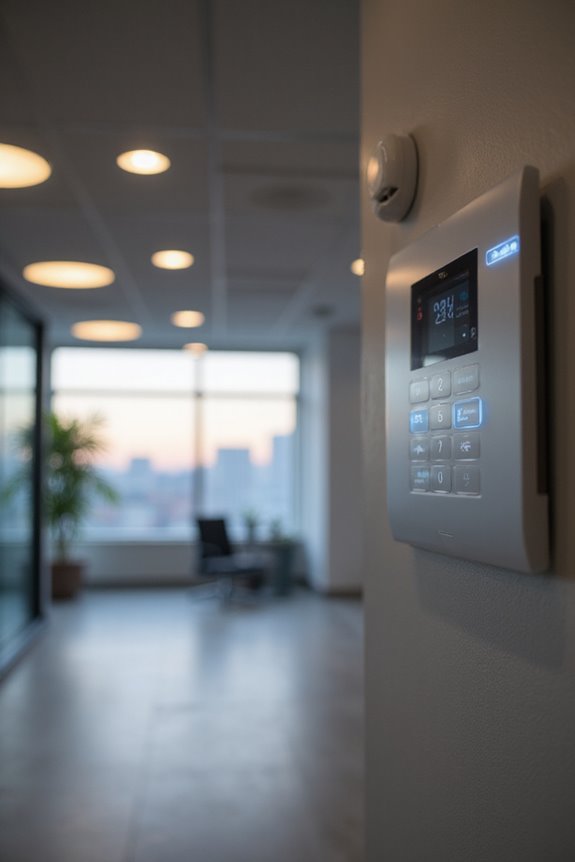
As the world becomes increasingly interconnected, automated lighting systems are proving to be indispensable for enhancing security and safety in our homes and businesses. These systems offer significant security deterrence by simulating occupancy through timed lighting schedules, making homes less attractive to potential intruders. When integrated with security alarms, lights can suddenly illuminate areas upon detecting movement, startling trespassers and enhancing occupant safety.
Furthermore, remote access allows me to monitor and control the lighting from anywhere, providing peace of mind. Continuous monitoring and instant alerts guarantee that any unusual activity is addressed promptly. Overall, combining automated lighting with traditional security measures creates a more robust defense against threats while guaranteeing a safe environment for occupants.
Tips for Enhancing Your Smart Lighting Experience
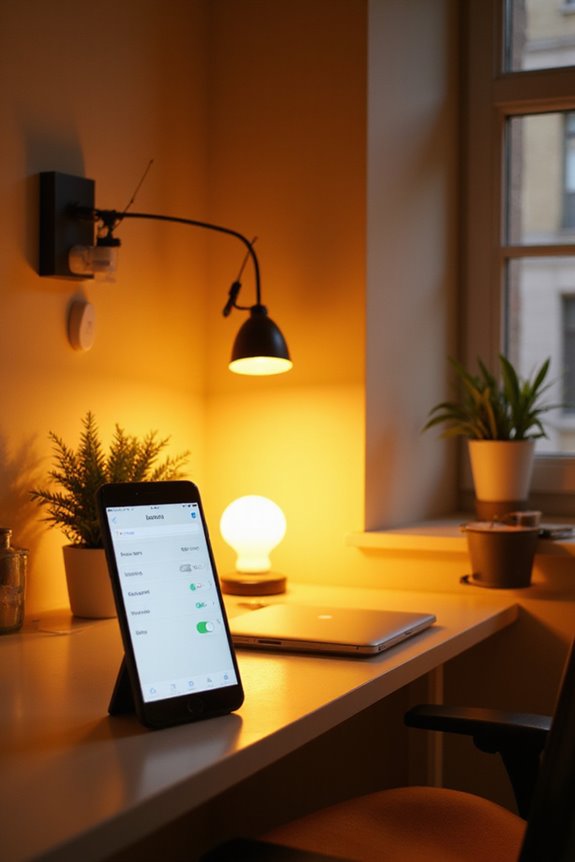
When it comes to enhancing your smart lighting experience, understanding the integration and compatibility of your devices is crucial. Make sure that your smart bulbs, hubs, and controllers communicate effectively by using common standards like Zigbee or Wi-Fi.
- Customize User Preferences: Adjust brightness and color temperature to match your moods and activities.
- Utilize Routines: Set schedules for your lights to turn on or off at specific times, aligning with your daily routine.
- Seasonal Adjustments: Use sensors to optimize lighting based on natural light availability, improving energy efficiency.
- Remote Access: Control your lighting from anywhere, guaranteeing convenience and security.
Frequently Asked Questions
Can I Use Smart Lighting With Existing Fixtures?
Imagine a painter with colors ready; I’ve found smart bulb types fit my existing fixtures perfectly. They blend seamlessly, no special tools needed. With a little creativity, I transformed my space into a vibrant masterpiece.
What if My Smart Lighting Device Is Not Responding?
If your smart lighting device isn’t responding, I recommend checking the troubleshooting tips. Also, verify device compatibility to avoid issues. It’s often just a matter of resetting or updating the firmware to get things working again.
Are Smart Bulbs Compatible With Dimmer Switches?
I’m often asked about smart bulb compatibility with dimmer switches. It’s essential to know that traditional dimmer switch limitations can cause issues, so I recommend using smart switches designed for seamless integration and performance.
How Many Smart Devices Can I Connect to One App?
Ever wondered how many smart devices you can control with one app? It really depends on the app compatibility and smart device limits; for instance, some apps allow over 100 devices, while others might restrict you.
Do Smart Lighting Systems Work During Power Outages?
Yes, smart lighting systems can work during power outages if they have emergency backup options. Post-power restoration, some lights reset automatically, while others require manual activation, depending on their settings and compatibility.


